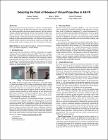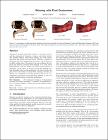Browsing by Author "O'Sullivan, Carol"
Now showing items 1-6 of 6
-
Detecting the Point of Release of Virtual Projectiles in AR/VR
O'Sullivan, Carol (2021)Our aim is to detect the point of release of a thrown virtual projectile in VR/AR. We capture the full-body motion of 18 participants throwing virtual projectiles and extract motion features, such as position, velocity, ... -
Eye-catching Crowds: Saliency based selective variation
O'Sullivan, Carol; Mc Donnell, Rachel (2009)Populated virtual environments need to be simulated with as much variety as possible. By identifying the most salient parts of the scene and characters, available resources can be concentrated where they are needed most. ... -
Perceptual evaluation of level of detail clothing for virtual humans
O'Sullivan, Carol; Mc Donnell, Rachel (2006)Recent developments in crowd simulation have allowed thousands of characters to be rendered in real-time. Usually this is achieved through the use of Level of Detail (LOD) models for the individuals in the crowd. ... -
Seeing is Believing: Body Motion Dominates in Multisensory Conversations
O'Sullivan, Carol; Mc Donnell, Rachel (2010)In many scenes with human characters, interacting groups are an important factor for maintaining a sense of realism. However, little is known about what makes these characters appear realistic. In this paper, we investigate ... -
Skinning with Dual Quaternions
Kavan, Ladislav; Collins, Steven; O'Sullivan, Carol; COLLINS, STEVEN (2007)Skinning of skeletally deformable models is extensively used for real-time animation of characters, creatures and similar objects. The standard solution, linear blend skinning, has some serious drawbacks that require artist ... -
Virtual Shapers & Movers: Form and Motion affect Sex Perception
O'Sullivan, Carol; Mc Donnell, Rachel; Newell, Fiona (2007)An experiment to determine factors that influence the perceived sex of virtual characters was conducted. Four different model types were used: highly realistic male and female models, an androgynous character, and a point ...









